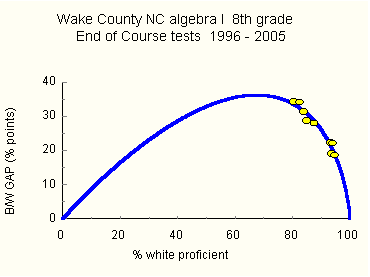|
Test-scores in Wake County have risen, mostly monotonically, since 1996. From an
h-bd perspective, however, none of this is particularly interesting. The ‘improvements’
have not narrowed black/white cognitive gaps. Proficiency criteria that include
reading do not provide good measures of cognitive gaps. Their g-loading is relatively small.
As Jerry has often pointed out, almost anyone can learn to read. Consequently, the B/W
reading gap rarely approaches the one
standard deviation observed on tests of reasoning ability. In fact, no cognitive gap closure has occurred in Wake County in the past decade. I looked at 8th-grade Algebra I end-of-course tests, taken by 13 and 14 year-olds. This test couples robust g-loading with adolescent hormones, and the result is not surprising.  The curve shown is the B/W percentage-point gap predicted if both group distributions are Gaussian. The parameter values are those giving the best (i.e., least squares) fit to point gaps observed in Wake County for the past 10 years (yellow dots). Least squares yields a B/W mean difference of 0.934 and a standard deviation ratio (B/W) of 0.983. As is evident, the fit is excellent and the mean difference so obtained is about what we have come to expect. (The 2004 point is omitted because a typo in the NC web site lists the percent proficient as zero for whites.) In sum, Wake County has reduced the B/W point gap between 1996 and 2005, without altering the cognitive gap. The county has either raised the level of performance across the board or lowered the standard for "proficient." The cognitive gap is invariant to both. |